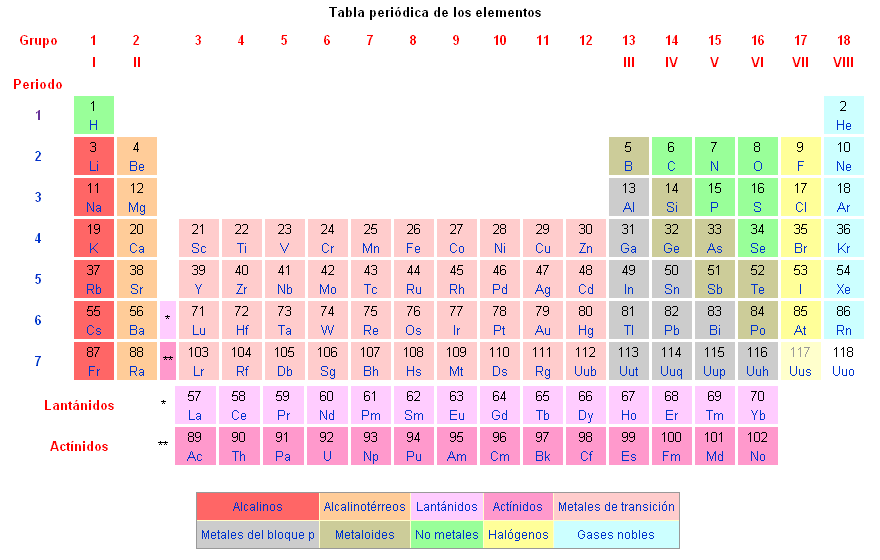
Isotopes are atoms whose atomic nuclei have the same number of protons but a different number of neutrons. Not all atoms of the same element are identical and each of these varieties corresponds to a different isotope.
The word isotope is used to indicate that all types of atoms of a chemical element are located in the same place on the periodic table.
Isotope definition
According to the definition of isotope, each of the same element has the same atomic number (Z) but each has a different mass number (A). The atomic number corresponds to the number of protons in the atomic nucleus of the atom. The mass number corresponds to the sum of neutrons and protons in the nucleus.
This means that the different isotopes of the same atom differ from each other only by the number of neutrons.

Although they may have any number of neutrons, there are some preferred combinations of protons and neutrons in different atoms.
Those that are light (with few protons and neutrons) tend to equal the number of neutrons and protons, while the heaviest tend to have more neutrons than protons.
Types of isotopes
Isotopes can be classified into three main categories based on their stability:
-
Stable isotopes: Are those that do not undergo radioactive decay. These isotopes have a balanced mix of protons and neutrons in their nucleus, giving them long-term stability. For example, Carbon-12, Oxygen-16 or Calcium-40.
-
Unstable or radioactive isotopes: They are those that undergo radioactive decay, emitting subatomic particles or radiation to reach a more stable configuration. Radioactive isotopes have either an excess or a lack of neutrons compared to the most stable configuration. Some examples are Uranium-238, Plutonium-239 or Carbon-14.
-
Semi-stable isotopes or radioisotopes: These are isotopes that are unstable but have a long half-life. Its radioactive decay is slower compared to other radioactive isotopes. Potassium-40 and Cesium-137 are examples of this type.
Unstable isotopes: definition and examples
Unstable isotopes, also known as radioisotopes, are those isotopes that undergo radioactive decay, emitting subatomic particles or radiation in an attempt to reach a more stable configuration.
These isotopes have either an excess or a lack of neutrons compared to the most stable configuration, making them unstable and prone to nuclear decay.
Here are some examples of unstable isotopes and some of their applications:
-
Uranium-238 (238U): It is an unstable isotope of uranium and is found naturally in the earth's crust. It is the precursor of the radioactive isotope uranium-235, which is used in the production of nuclear power and in the manufacture of nuclear weapons.
-
Plutonium-239 (239Pu): It is an unstable isotope of plutonium and is produced from the uranium-238 isotope in nuclear reactors. It is used in the production of nuclear weapons and in nuclear fission reactors.
-
Carbon-14 (14C): It is an unstable isotope of carbon that forms in the atmosphere due to the interaction of cosmic rays. It is used in radiocarbon dating to determine the age of archaeological and geological objects.
-
Iodine-131 (131I): It is an unstable isotope of iodine and is produced in nuclear reactors. It is used in nuclear medicine for the treatment of hyperthyroidism and thyroid cancer, as it emits beta and gamma radiation that can destroy abnormal thyroid cells.
-
Cesium-137 (137Cs): It is an unstable isotope of cesium and is formed as a by-product of nuclear fission. It is used in industrial applications, in radiotherapy and in the measurement of seismic activity.

Stable isotopes: definition and examples
Stable isotopes are those isotopes that do not undergo radioactive decay and maintain their nuclear composition over time. This means that they have a balanced mix of protons and neutrons in their nucleus, giving them long-term stability.
Here are some examples of stable isotopes and their applications:
-
Carbon-12 (12C): It is the most abundant isotope of carbon on Earth. It is used in organic chemistry as a reference for the determination of molecular masses and in mass spectrometry for instrument calibration.
-
Oxygen-16 (16O): It is the most common isotope of oxygen and is found in the atmosphere, water and minerals. It is used in cellular respiration and in the formation of chemical bonds in many biological reactions.
-
Hydrogen-1 (1H): It is the most common isotope of hydrogen and is used in a wide range of applications. It is essential in the formation of biological molecules, such as water, and is used in the production of ammonia and other chemicals.
-
Nitrogen-14 (14N): It is the most common isotope of nitrogen and is found in the atmosphere in large quantities. It is used in the synthesis of fertilizers and in uranium enrichment processes.
-
Calcium-40 (40Ca): It is the most abundant isotope of calcium on Earth and is found in bones, teeth and other tissues. It is essential for muscle contraction, blood clotting, and bone structure.
Semi-stable isotopes: definition and examples
Semi-stable isotopes, also known as long-lived isotopes, are those isotopes that have a significantly longer half-life compared to typical radioactive isotopes.
Although they are unstable and eventually break down, their half-life is long enough for them to be considered "semi-stable".
Some examples of semi-stable isotopes:
-
Potassium-40 (40K): It is a semi-stable isotope of potassium that has a half-life of approximately 1.3 billion years. It is used in the radiometric dating of rocks and minerals, especially in the dating of volcanic rocks.
-
Rubidium-87 (87Rb): It is a semi-stable isotope of rubidium with a half-life of approximately 49 billion years. It is used in the radiometric dating of minerals and rocks, especially in the dating of minerals such as feldspar.
-
Samarium-147 (147Sm): It is a semi-stable isotope of samarium with a half-life of approximately 106 billion years. It is used in the radiometric dating of minerals and rocks, especially in the dating of minerals such as apatite.
-
Uranium-235 (235U): Although it is considered an unstable isotope, its half-life of approximately 704 million years places it in an intermediate category. It is used in the nuclear power industry as a fuel in nuclear reactors and is also important for the production of nuclear weapons.
What is the half-life of an isotope?
The half-life of an isotope is the average time it takes for it to decay to half its initial amount. It is a measure used to describe the stability or decay rate of a radioactive isotope.
When a radioactive isotope decays, it emits subatomic particles or radiation to reach a more stable configuration. Half-life refers to the time it takes for half of the atoms of a given isotope to decay.
Isotopes of natural and artificial origin
Isotopes can be classified into two main categories: naturally occurring or man-made.
Naturally occurring isotopes
Naturally occurring isotopes are those found in nature and produced naturally through geological, astronomical, and biological processes.
These isotopes have existed since the formation of the Earth and are found in minerals, water, air, plants, animals, and living organisms.
Some examples of naturally occurring isotopes are:
-
Carbon-12 (12C)
-
Hydrogen-1 (1H)
-
Oxygen-16 (16O)
-
Uranium-238 (238U)
-
Potassium-39 (39K)
Isotopes of artificial origin
Isotopes of artificial origin are those that are produced by human activities, either by means of nuclear reactions in laboratories or by induced radioactivity in nuclear reactors.
They generally do not exist naturally in significant numbers on Earth. Some examples of artificial origin are:
-
Plutonium-239 (239Pu)
-
Technetium-99m (99mTc)
-
Cobalt-60 (60Co)
-
Iodine-131 (131I)
-
Americium-241 (241Am)
Man-made isotopes are used in a wide range of applications, such as in nuclear medicine for diagnosis and treatment, in industry for non-destructive testing, in scientific research, and in power generation in nuclear reactors.
In addition, some isotopes of artificial origin are used in military applications and in the manufacture of nuclear weapons.